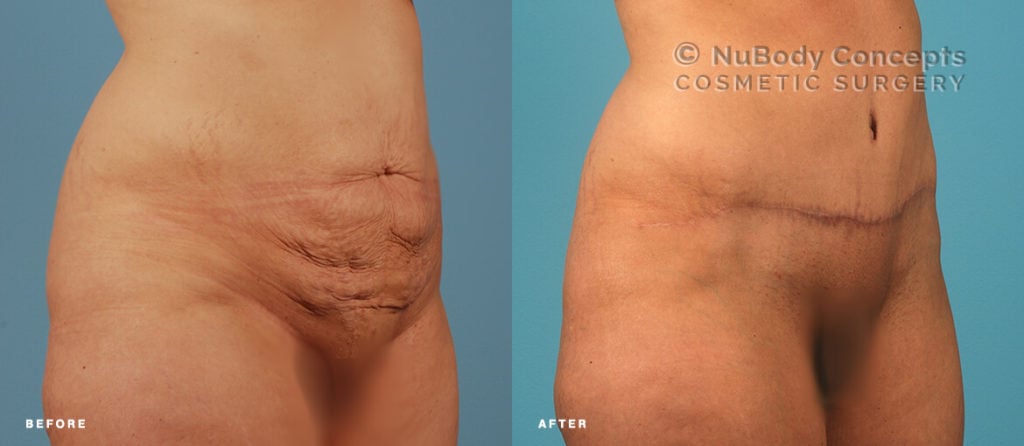
Medically reviewed by Dr. John Rosdeutscher – Written by Sine Thieme
Is a Tummy Tuck Safe?
Tummy tucks are among the top 5-6 most popular plastic surgery procedures in the United States, meaning they are performed often and are therefore relatively routine procedures.
Any plastic surgery bears inherent risks. It is important to weigh these risks versus the potential benefits of your procedure so that you can make an informed decision. In fact, your plastic surgeon will discuss potential risks with you and have you sign a so-called informed consent document outlining these risks and other important information. Below we will give an overview of the risks of tummy tuck surgery.
Risks of Tummy Tuck Surgery
As with any surgery, a tummy poses its own risks. The most common include bleeding, blood clots, infection, or complications from general anesthesia. However, a tummy tuck is considered a very safe procedure. What you do following surgery and how you follow your surgeon’s instructions can help ease post-op pain, bleeding, and prevent infection or other complications.
It is best to discuss all potential risks and the pros and cons with your surgeon before deciding to have the procedure. Although the results are generally permanent, it is important to understand that significant weight gain or loss, pregnancy post-operation, or additional procedures may affect the appearance of the abdomen.
A few risks to be aware of before considering an abdominoplasty:
Changes in Skin Sensation
Directly after the procedure, you may notice reduced sensation or increased numbness in your abdominal area. Repositioning the abdominal tissues can affect the nerves in your abdomen or upper thighs. In most cases this is temporary and will resolve on its own, typically in six to eight weeks. If a loss of sensation persists long after you’ve had a tummy tuck, you should alert your surgeon.
The same is true for any excessive itching or increased sensitivity to hot or cold temperatures after surgery.
Unexpected Scarring
It is important to be aware that any abdominoplasty procedure will leave a permanent scar. However, it is placed just below the bikini line and is often easily hidden. The length and visibility of the scar will vary from person to person and with the type of tummy tuck you’re having done.
Belly Button Distortion
This is not so much a risk as it is a feature of a tummy tuck: Your belly button will end up distorted or rather disappear altogether during an abdominoplasty. This happens because of the way the skin is tightened. The surgeon removes the excess skin of the lower abdomen, and the remaining skin is pulled down and tightened. Your belly button would end up very low on your abdomen and look very out of place.
However, your plastic surgeon will take this into account and create a new belly button for you as part of your abdominoplasty. It should end up slightly oval, not round, and be positioned where it normally appears.
Designing and placing a new belly button should be a part of any tummy tuck surgery. Make sure you discuss your goals for a belly button with your plastic surgeon during your consultation. A so-called designer belly button is the centerpiece of tummy tuck surgery and should be given great consideration.
General Risks of Surgery
Any surgery can cause a number of complications including infection, fluid accumulation, cardiac and pulmonary complications, poor wound healing, or deep vein thrombosis. It can also inadvertently damage deeper structures such as nerves, blood vessels, muscles, lungs and abdominal organs.
All these risks are relatively rare and not specific to a tummy tuck. Again, they will be outlined to you in your informed consent document prior to surgery. Here are a few:
Anesthesia Risks
A tummy tuck is a surgical cosmetic procedure typically performed under local anesthesia combined with IV sedation. This type of sedation is comparable to getting a colonoscopy or having your wisdom teeth removed, except that the sedation will last longer for a tummy tuck – especially if you combine it with, say, a breast augmentation for a complete mommy makeover. General anesthesia is not required for a tummy tuck.
All anesthesia carries a certain risk, but complications from abdominoplasty under IV sedation are rare.
Bruising & Swelling
It is normal to experience some bruising and swelling after any type of surgery, so you should expect it after your tummy tuck. It typically takes several weeks to resolve, but in rare cases could persist longer. It is important to follow all of your plastic surgeon’s post-op instructions to ensure a smooth recovery. Keeping well hydrated helps to reduce swelling faster.
You might also develop a hematoma after tummy tuck surgery. This is caused by the pooling of blood and can occur up to several days after your procedure. Your surgeon will typically place a drain to absorb the blood and minimize the risk of developing a hematoma, but it can still happen for some patients.
Should you experience extreme bruising & swelling or be concerned about a hematoma, contact the office’s after hours nurse line to make sure it is not an indication of bleeding or a possible infection.
Poor wound healing
This often occurs as a result of poor aftercare or increased activity too soon after surgery. It may cause the surgical site to separate or heal poorly. Antibiotics given during or after surgery can help prevent infection from poor healing.
Risks from Smoking
Smoking is another risk factor not specific to a tummy tuck but true for all surgeries. People who smoke, chew tobacco, or use it in the form of nicotine patches, gum, or nasal spray, as well as to a lesser extend people who are exposed to secondary smoke, are at a greater risk of suffering from surgical complications. These can come in the form of skin and tissue dying (a condition called necrosis), delayed healing, or additional scarring.
Smoking also poses increased anesthesia risks and can delay the recovery from sedation.
All this to say that it is best if you don’t smoke. Your plastic surgeon will have you sign a disclosure form about your smoking habits and may not take you on as a patient if he or she deems the potential risks from your smoking, perhaps combined with other factors, as too high. If you have smoked in the past, be sure to disclose this in your consent.
Scarring After a Tummy Tuck
The scar is not so much a risk factor but a feature of a tummy tuck. Some patients choose a less-invasive skin tightening option to avoid the longer scar of a tummy tuck.
The noticeability of your scarring post-tummy tuck will vary depending on the method of your tummy tuck procedure.
A full abdominoplasty scar may reach from hip bone to hip bone and, at times, around the navel. It may have a V or U shape in appearance. Your doctor will determine the shape and length of the incision based on your personal preference or the amount of correction desired.
A mini-tummy tuck has no incision near the navel and it can be easily hidden in the pubic region. The length of the incision will vary depending on how much skin your doctor removes.
high lateral tension or extended abdominoplasty scars are often higher and longer than a traditional or mini-tummy tuck.
The good news is that an experienced plastic surgeon can “disguise” your tummy tuck scar so well that it won’t pose a problem, even in a bathing suit. The horizontal scar varies in length depending on the type of tummy tuck you are having, and is typically placed below the bikini line. In addition, the scar will fade over time to be much less noticeable. It is important to follow your surgeon’s post-op instructions to promote good healing.
Each patient’s skin is different and heals at a different pace. Your scar may begin to fade a few weeks after the procedure, or it may take up to a year for the redness to recede. It is also possible to undergo scar revision at a later date to improve a scar from a previous tummy tuck.
Minimizing Tummy Tuck Risk
If reading about these risks may make you anxious, remember that severe complications from a tummy tuck are rare. Tummy tucks are safe and effective, especially when performed by an experienced plastic surgeon. It’s a good idea to choose a board-certified plastic surgeon, meaning he or she has undergone regular recertification, to ensure a smooth procedure with minimal risks.
The most important thing you can do to have a successful tummy tuck surgery with the results you envision is to follow your plastic surgeon’s post-op instructions faithfully. Make sure you don’t miss any post-op appointments. You will typically see immediate results, given that so much excess skin will be removed. After a few weeks the swelling should subside, and at the 6 month mark your scar should have begun to fade.
Check out our Tummy Tuck Before & After Gallery for some examples. You will see the different degrees of fading of the scar, as well as placement and shape of the belly button.


We hope we have helped you gain a better understanding of tummy tuck safety and risks. Please contact us if you have any additional questions.
If you are ready to get started, use the pink button to schedule a consultation with our board-certified plastic surgeon in Nashville or Memphis.
References:
American Society of Plastic Surgeons: Plastic Surgery Statistics Report 2019












